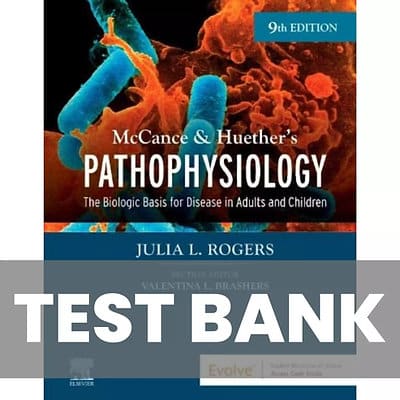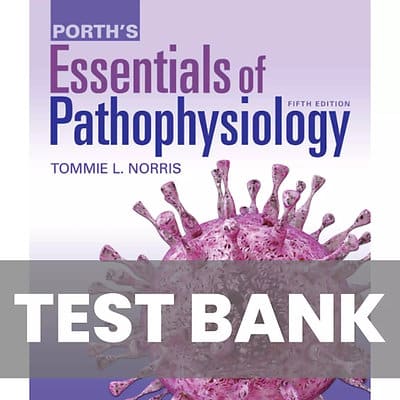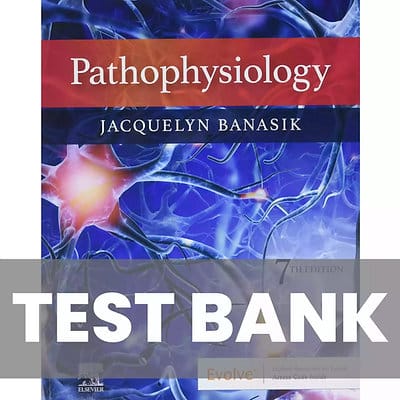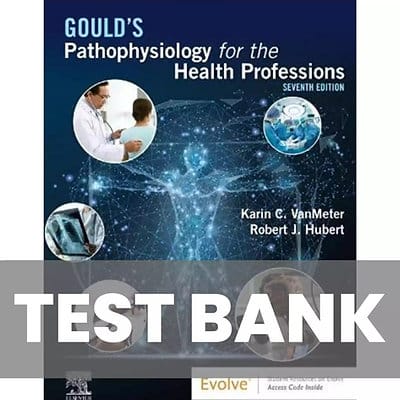Porth’s Pathophysiology Concepts Of Altered Health States 9th Edition By Grossman – Test Bank
1. A 40-year-old patient had an annual physical exam with routine lab tests. The patient’s lab values include the following:
Hgb 13.8 g/dL
Hct 40%
BG fasting 146 mg/dL
Triglycerides 200 mg/dL
Total cholesterol 231 mg/dL
LDL 175 mg/dL
HDL 30 mg/dL
The client was counseled to begin an exercise and diet regime for his health. After implementing healthy lifestyle changes 6 months ago, follow-up lab tests were drawn. Which of the following lab values indicate that the changes have been effective?
A) Triglycerides elevated to 210 mg/dL
B) LDL level decreased to 120 mg/dL
C) Hgb decreased to 12.3 g/dL
D) HDL increased to 35 mg/dL
Ans: B
Feedback:
Physical activity and exercise can help maintain weight control and CV fitness. Physical activity and exercise can lower LDL and increase HDL in persons with hyperlipidemia and have better regulation of blood glucose.
2. The primary care provider knows which of the following statements below will also benefit an adult client with a diagnosis of diabetes mellitus performing isometric exercise to help control his blood glucose levels?
A) A reduction in the amount of adipose tissue
B) An increase in his basal metabolic level
C) Increased efficiency in the use of oxygen by his muscles
D) Improved range of motion in his joints
Ans: B
Feedback:
Increased basal metabolic level is associated with isometric exercise; thus, better blood glucose control should improve. Loss of fat and increased oxygen use efficiency are associated with aerobic exercise. Range of motion of the joints results from stretching exercises.
3. The nurse knows a client who is a long-distance runner is able to respond effectively to the increased oxygen demands while running is due to which of the following statements listed below?
A) Sympathetic and parasympathetic stimulation associated with muscle metabolism mediate hypothalamic control of cardiovascular activity.
B) End products of muscle metabolism cause vagal stimulation of the medullary cardiovascular centers.
C) The insular and anterior cingulated cortex interacts with the hypothalamic centers, resulting in stimulation of the medullary cardiovascular centers.
D) Vasodilation results from increased oxygen demand of renal and gastrointestinal blood vessels.
Ans: C
Feedback:
The cardiovascular response to exercise is accomplished through the insular and anterior cingulated cortex interacting with the hypothalamic centers. This causes stimulation of the medullary cardiovascular centers and, ultimately, increased cardiac output. Answers A, B, and D do not represent physiological processes associated with exercise and increased oxygen demand.
4. The nurse knows the differences between slow-twitch fibers and fast-twitch muscle fibers. Slow-twitch fibers can be described by which of the following statements listed below? Select all that apply.
A) Perform lower-intensity work for prolonged periods.
B) Run long distances such as a marathon.
C) Have more efficient high-intensity workouts at the gym.
D) Utilize anaerobic metabolism as a source of energy.
E) Participate in a long-distance bike marathon.
Ans: A, B, E
Feedback:
Slow-twitch fibers, which are smaller than fast-twitch fibers, tend to produce less overall force but are more energy efficient and better suited biochemically to perform lower-intensity work for prolonged periods. Examples of exercises that use slow-twitch fibers are long-distance running, swimming, and cycling, where endurance is desired. Fast-twitch fibers are suited for high-intensity workouts and utilize anaerobic metabolism.
5. The nurse knows that an older adult client with a diagnosis of heart failure (HF) will most likely have compromised ability to perform activities of daily living upon discharge due to which of the following statements listed below?
A) The client’s musculature will be dependent on aerobic metabolism.
B) The client’s diagnosis will have contributed to cardiac muscle atrophy.
C) Intramuscular acidification will cause the client to be more easily fatigued.
D) The client will have experienced a shift toward the use of slow-twitch muscle fibers.
Ans: C
Feedback:
HF patients experience increased fatigability due to intramuscular acidification. He will be more dependent on anaerobic metabolism and has likely experienced skeletal muscle atrophy and a shift toward increased fast-twitch muscle fibers.
6. A young healthy adult helps lift a sofa to move it 25 feet. The nurse knows which of the following sources of energy listed below will the client most likely use in this process?
A) Amino acids
B) Stored ATP
C) Fatty acids
D) Glucose
Ans: B
Feedback:
Stored ATP, creatine phosphate, and muscle glycogen are among the first energy sources utilized during aerobic exercise. Amino acids, fatty acids, and glucose are utilized after prolonged periods of exercise.
7. A nurse holds an exercise class for older adults and knows which of the following statements listed below by a class member requires clarification?
A) “Regular exercise can prevent the blood clots that cause many strokes.”
B) “Exercise can help you digest your food more quickly and efficiently.”
C) “Physical activity can help diabetics stabilize their blood sugars.”
D) “Exercise can help to keep down the salt levels that cause high blood pressure.”
Ans: D
Feedback:
Prolonged exercise contributes to dehydration and electrolyte imbalances. Low sodium levels should be maintained and replaced. High sodium intake is causative of hypertension. Answers A, B, and C all convey demonstrated benefits of physical exercise.
8. The nurse knows prior to an elderly adult starting a cardiac rehabilitation exercise program, he or she should review which of the following objective data noted below to ensure client safety?
A) Echocardiogram with measure of ejection fraction
B) Transesophageal echocardiogram to assess for aortic aneurysm
C) Treadmill ergometry to measure maximal oxygen consumption and heart rate
D) Blood gas analysis looking for any metabolic acidosis
Ans: C
Feedback:
Bicycle or treadmill ergometry measures heart rate, and other responses during exercise. Echocardiograms for EF, TE echocardiograms, and blood gas analysis are not performed in the rehab setting.
9. The nurse knows which of the following clients might experience fatigue relative to physiologic, psychological, and/or pathologic aspects? Select all that apply.
A) An elderly client on tranquilizers for sleep in the noisy nursing home environment
B) An adult who performs manual outdoor labor as a roofer
C) An adolescent client with a diagnosis of leukemia on a chemotherapy regimen
D) An adult client who teaches art to a small group of children in kindergarten
E) An adult technician working in a sleep lab where lights are dimmed and noise is kept at a minimum
Ans: A, B, C
Feedback:
The origin or cause of fatigue can be physiologic, psychological, pathologic, or unknown. It can be caused by environmental factors (excess noise, temperature extremes, and changes in weather); drug-related incidents (use of tranquilizers); treatment-related causes (chemotherapy); physical exertion (exercise); and psychological (monotony).
10. The nurse knows which of the following clients listed below is most likely to exhibit signs and symptoms of fatigue?
A) An obese client with a recurring flulike illness, muscle and joint pain, headaches, and sleep problems
B) A sleep-deprived new mother with headache, sore throat, and anemia
C) A woman with breast cancer, joint pain, lack of motivation, and inability to concentrate
D) A client with major depression, allergies, and history of type 1 diabetes
Ans: A
Feedback:
This client fulfills the diagnostic criteria for chronic fatigue syndrome (CFS). The other three clients fulfill some of these criteria but not enough to qualify for a diagnosis of CFS; they also have other conditions that may be causing their fatigue.













Reviews
There are no reviews yet.